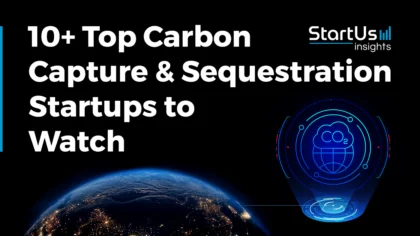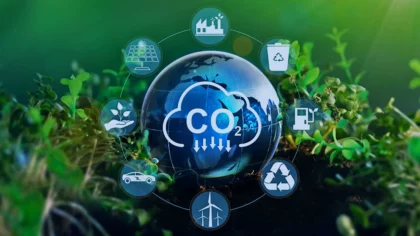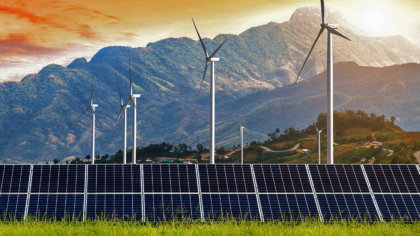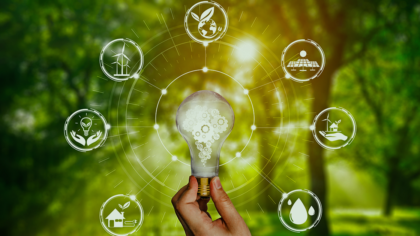Carbon Capture Utilization & Storage Startups presents a promising solution to mitigate the impact of climate change by capturing carbon emissions from industrial processes and storing them underground or converting them into useful products.
The global Carbon Capture Utilization & Storage market is projected to reach a market size of USD 9.98 billion by the end of 2030. Over the forecast period of 2024 to 2030, the market is projected to grow at a CAGR of 19.5%. Read on to explore 30 carbon capture utilization & storage startups that are set to advance the circular economy in 2025.
Global Startup Heat Map highlights 30 Carbon Capture Utilization & Storage Startups
Through the Big Data & Artificial Intelligence (AI)-powered StartUs Insights Discovery Platform, covering over 5M+ startups & scaleups globally alongside 20K+ technologies & trends, we identified 1300 CCUS startups.
The Global Startup Heat Map below highlights the 30 CCUS startups you should watch in 2025 as well as the geo-distribution of 1300+ startups & scaleups we analyzed for this research. According to our data, we observe high startup activity in Europe and the United States, followed by India. The top 5 Startup Hubs for London, New York, Singapore, San Francisco, and Houston.
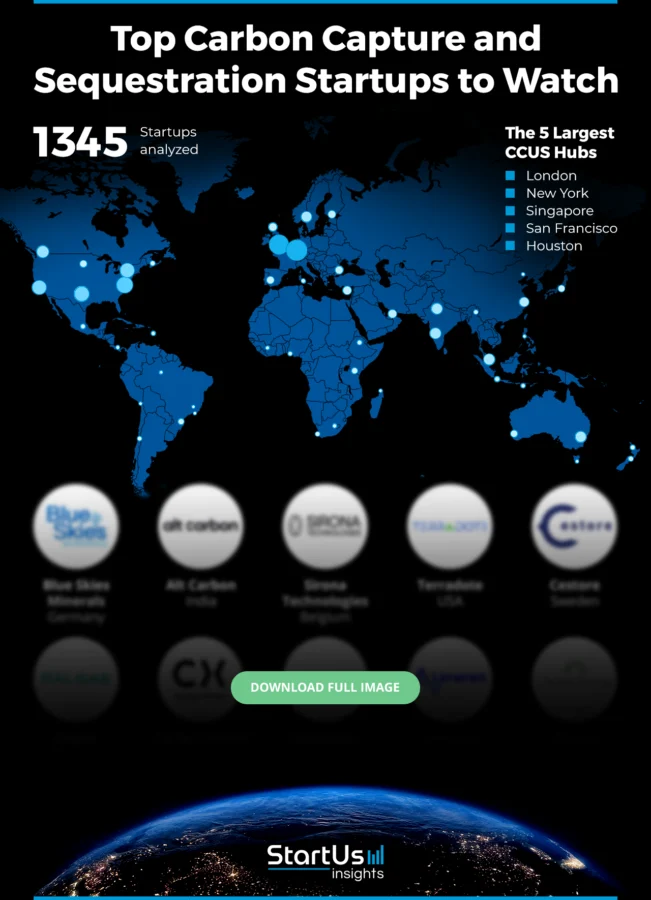
Meet 30 Carbon Capture Utilization & Storage Startups to Watch in 2025
We hand-picked startups to showcase in this report by filtering for their technology, founding year, location, funding, and other metrics. These CCUS startups work on solutions ranging from natural carbon removal and low-energy DAC to enhanced weathering and C02 sequestration panels.
- Greenlyte Carbon Technologies (GCT) – Low-energy Direct Air Capture (DAC)
- CREW Carbon – Natural Carbon Removal
- Airhive – Fluidization-based CO2 Sequestration System
- Airbuild – CO2 Sequestration Panels
- Everest Carbon – Enhanced Weathering
- Meloon – Graphene-based CO2 Removal
- Carbonaide – CO2 Utilization & Storage in Concrete
- Arbon Earth – Algae-based CO2 Sequestration
- CyanoCapture – Biological Carbon Fixation
- Sustaera – Renewable Energy-based CO2 Removal
- Capture6 – Carbon in Mineralized Form
- NeoCarbon – Renewable Energy-based CO2 Removal
- Parallel Carbon – Cost-Effective Carbon Capture
- CarbonWorks – Microalgae-based CO2 Capture
- Silicate – Carbon to Concrete
- Qaptis – In-situ Carbon Capture
- RepAir – On-site CO2 Utilization & Storage
- RedoxNRG – CO2 to Green Chemicals
- Nellie Technologies – Carbon Capture as a Service
- Mantel – Heavy Industry CO2 Emissions
- Blue Skies Minerals – Large-scale CO2 Storage
- Alt Carbon – Enhanced Rock Weathering Solution
- Sirona Technologies – Direct Air Capture Technology
- Terradote – Carbon Sequestration and Utilization
- Cestore – Ocean-based Carbon Removal Solution
- Palgae – Algae-based Carbon Capture Technology
- Carbon Xtract – Nanomembrane-based CO2 Capture
- Stathmos – On-site Carbon Capture Solution
- Limenet – Permanent CO2 Storage in Seawater
- Oxylus Energy – Electrolysis-based Carbon-neutral Fuels
1. Greenlyte Carbon Technologies
- Founding Year: 2022
- Location: Essen, Germany
- Use for: Low Temperature DAC, Green Hydrogen
Greenlyte Carbon Technologies (GCT) builds a low-energy DAC system that turns ambient air into green hydrocarbons. The process involves the absorption of the air in a liquid sorbent solution and precipitation as hydrogen carbonate.
It is followed by desorption either through alkaline water electrolysis, which produces hydrogen as a byproduct, or through thermal, low calorific waste heat. Thus, GCT not only removes atmospheric CO2 using minimum energy but also produces green hydrogen, further enabling a circular economy.
2. CREW Carbon simplifies Natural Carbon Removal
- Founding Year: 2022
- Location: Hamden, CT, USA
- Use for: CDR & MRV Sensors
CREW Carbon enables carbon extraction using naturally occurring minerals. These minerals, specifically carbonate rocks, undergo weathering, converting atmospheric CO2 into bicarbonate. This bicarbonate, a stable carbon form, persists in aquatic environments for extended periods. The process requires three primary components — water, carbon dioxide, and carbonate rock. Adjusting their ratios accelerates carbon removal from millennia to hours.
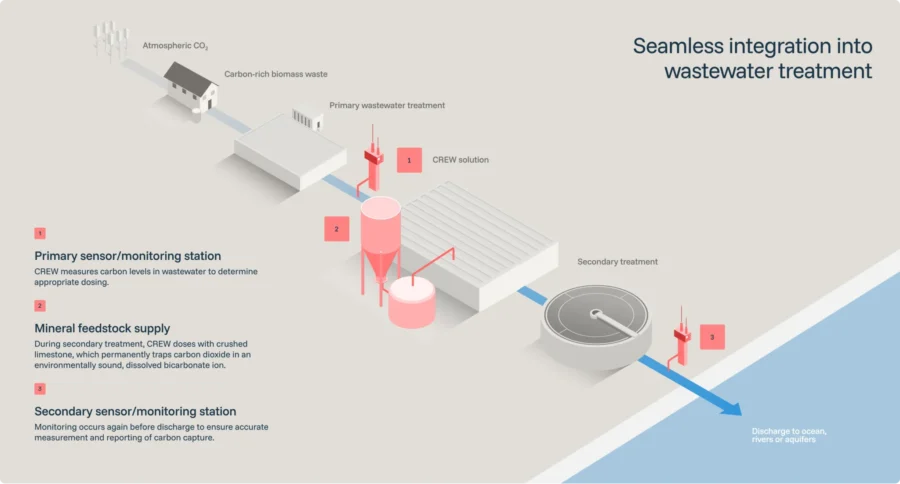
CREW employs specific systems to combine these elements, optimizing carbon extraction. Its patented carbon dioxide removal (CDR) and measurement, reporting & verification (MRV) sensors, in conjunction with geochemical dissolution models, monitor real-time carbon chemistry in water. This technology seamlessly integrates with existing infrastructure, facilitating effective CO2 removal and accurate measurement.
3. Airhive
- Founding Year: 2022
- Location: London, UK
- Use for: Hybrid Geochemical DAC
Airhive develops JD002, a CO2 capture system based on fluidization. The startup uses naturally carbon-absorbing rock minerals and increases their capacity to uptake CO2 by reforming them into small particles with very high surface areas.
Airhive’s JD002 consists of two components — a capture system (reactor) and a calciner. Fans blow air vertically into the reactor. Whereas, the sorbent rapidly captures the CO2 in the air. Carbonated sorbent is transferred to the calciner and stripped of CO2. Finally, the purified CO2 is stored and the sorbent is recycled back to the capture system,
4. Airbuild
- Founding Year: 2021
- Location: San Diego, CA, USA
- Use for: Green Buildings
Airbuild enables carbon sequestration on commercial buildings. Its product, Plant Panel, uses algae to filter air and sequester CO2 emissions, while also acting as solar panels generating electricity. Airbuild integrates the Internet of Things (IoT) technology to offer real-time data reporting on carbon offsets. Additionally, the startup provides various installation options including roof mounts and side panels.
5. Everest Carbon
- Founding Year: 2022
- Location: San Francisco, CA, USA
- Use for: Permanent CO2 Storage
Everest Carbon specializes in carbon dioxide removal through the application of rock powder. Utilizing enhanced weathering technology, the company accelerates Earth’s natural carbon cycle to capture CO2. Enhanced rock weathering (ERW) amplifies the natural carbon cycle on a significant scale.
The process not only captures CO2 but also improves soil health and increases crop yields. Cations and sequestrated CO2 flow to the ocean, restoring its natural pH. It then turns into carbonates and falls into the ocean floor, leading to permanent CO2 storage.
6. Meloon
- Founding Year: 2022
- Location: Munich, Germany
- Use for: Post Combustion CO2 Separation
Meloon is a startup that makes a nanoporous graphene-based CO2 separation membrane, Magic Filter. Since the CO2 permeability of a membrane is inversely proportional to the thickness of the layer, Meloon uses single-layer graphene, which has the thickness of only one atom.
This filter effectively separates the molecules of oxygen, nitrogen, and carbon dioxide post-combustion. Thus, it solves the energy and cost-related problems of solvent-based CO2 purification technologies.
7. Carbonaide
- Founding Year: 2022
- Location: Joensuu, Finland
- Use for: Carbon Negative Concrete
Carbonaide is a startup that carbonizes pre-cast concrete, emphasizing sustainable CO2 value chains. This method is compatible with cement mixtures, enabling reduced cement consumption. By mineralizing CO2 into concrete, the technology diminishes the overall carbon footprint.
Moreover, Carbonaide’s carbon curing technology produces carbon-negative concrete. When combined with low carbon footprint binders, the concrete’s carbon footprint becomes negative. Hence, this positions precast plants as potential carbon sinks.
8. Arbon Earth
- Founding Year: 2021
- Location: Gothenburg, Sweden
- Use for: CO2 Binding in Seabed, Fish Nurseries
Arbon Earth is a startup that makes a carbon capture solution, Oceanpod. It removes CO2 from the atmosphere and stores it in the seabed by cultivating fast-growing algae. The product consists of two parts — one that keeps the Oceanpod floating, with the lifting force decreasing over time. The second part is a biodegradable rope on which the algae grows.
The algae is grown on ropes offshore and eventually sinks below the surface as it becomes fully grown, thus binding the carbon in the seabed for long periods. In addition to carbon sequestration, Oceanpod serve as fish nurseries by providing habitat on the ropes and after sinking.
9. CyanoCapture
- Founding Year: 2021
- Location: Oxford, UK
- Use for: Cyanobacteria-based CO2 Capture
CyanoCapture develops a plug-and-play photobioreactor that uses Synechococcus, a type of photosynthetic bacteria for energy-efficient carbon capture. The startup’s solution captures CO2 without the need for expensive catalysts or sorbents.
The process involves bubbling raw flue gas through special containers where the bacteria quickly absorb CO2 and convert it into biomass and biological oils. Moreover, the solution’s modular design enables scalability, adjusting carbon removal capacity to specific emission site needs.
10. Sustaera
- Founding Year: 2021
- Location: Cary, NC, USA
- Use for: Direct Air Capture, CO2 Emission Reduction
Sustaera is a startup that builds a modular carbon removal system, DAC 2.0. Its direct air capture (DAC) technology uses clean electricity to eliminate new emissions. The solution operates in diverse environments — open grasslands to arid deserts to tropical savannas, ensuring consistent performance.
The modular design enables continuous operation and efficient land use. Moreover, Sustaera leverages existing supply chains for rapid technology deployment. This approach ensures efficient scalability and resource utilization.
11. Capture6
- Founding Year: 2021
- Location: Berkeley, CA, USA
- Use for: Mineralized Carbon Storage, Direct Air Capture
Capture6 develops a permanent and irreversible carbon removal solution. The startup uses a direct air capture (DAC) system that adheres to its SPACERS framework. It requires the capturing of carbon dioxide (CO2) from ambient air and storage in mineralized form.

Capture6 stores CO2 as mineral carbonates like calcium carbonate and sodium carbonate. These stable carbonates avoid the risk of leakage and minimize the impact on local ecosystems. The solution avoids the risks posed by geological CO2 storage solutions in the form of water and soil contamination.
12. NeoCarbon
- Founding Year: 2021
- Location: Berlin, Germany
- Use for: Direct Air Capture through Cooling Towers
NeoCarbon offers a retrofit DAC technology for industrial applications. The startup uses existing infrastructure in the form of cooling towers to perform DAC. NeoCarbon develops DAC kits that are installed or retrofitted to cooling towers.
This process utilizes the massive amounts of air moving through cooling towers to remove CO2 at very low additional cost and time. The startup’s technology thus leverages the current infrastructure without impacting its original functionality to capture CO2 directly from the air.
13. Parallel Carbon
- Founding Year: 2021
- Location: London, UK
- Use for: Accelerated Mineral-based DAC, Carbon Management
Parallel Carbon develops a carbon removal technology that removes atmospheric CO2 while producing hydrogen to eliminate emissions. The startup offers a cost-effective carbon management solution by combining geomimicry with electrochemistry.
Parallel Carbon’s DAC system uses a mineral-based capture medium to absorb CO2. The solution also offers a proprietary electrolyzer that creates the acids and bases that aid the regeneration of this capture medium aiding sustainable operations. In addition, the startup also produces green hydrogen and other infrastructure materials as byproducts, facilitating an extra revenue stream.
14. CarbonWorks
- Founding Year: 2021
- Location: Libourne, France
- Use for: Algae-based Carbon Capture, Photobioreactor
CarbonWorks develops an industrial platform for CO2 capture by microalgal photosynthesis. The startup’s photobioreactor captures CO2 emissions from industrial sources and makes them available to photosynthetic microalgae.
These microalgae grow and produce molecules that serve as replacements for fossil-based compounds. CarbonWorks thus enables industrial players to convert their CO2 emissions into efficient and safe raw materials on a large scale. In this way, the startup reduces the consumption of agricultural land and water, preserving biodiversity.
15. Silicate
- Founding Year: 2022
- Location: Sligo, Ireland
- Use for: Enhanced Mineral Weathering Capture, CO2 Removal
Silicate develops a proprietary material that enhances the mineral weathering of concrete to capture carbon. The startup processes returned and demolished concrete to amplify its sequestration potential. The innovative material chemistry allows concrete to weather much more quickly than other rocks and minerals.
This aids in the permanent removal of excess CO2 from the atmosphere by depositing it on agricultural fields. The material also improves crop productivity through pH amendment and ameliorates plants’ natural resistance to herbivory all while facilitating CO2 capture.
Want to explore 1300+ CCUS startups & scaleups?
16. Qaptis
- Founding Year: 2020
- Location: Lausanne, Switzerland
- Use for: On-board Carbon Capture, CO2 Sequestration
Qaptis provides a plug-in technology to capture CO2 emissions directly at their sources. The startup’s retrofit solution for heavy-duty trucks captures CO2 directly from the exhaust gas, liquefies it, and stores it on board.
The captured CO2 is then unloaded in fixed intervals for valorization into building materials, synthetic fuels, and plastics. In this way, the solution turns trucks into low-emission vehicles with low upfront costs and no drastic infrastructure changes.
17. RepAir
- Founding Year: 2020
- Location: Yokneam Iilit, Israel
- Use for: Selective Carbon Capture Membrane
RepAir is developing an electrochemical Direct Air Capture (DAC) technology that utilizes electricity to separate CO₂ from the air. The startup’s unique selective membrane under the influence of electricity separates CO2 from the atmospheric air streams.
The clean air then goes back to the atmosphere while the pure CO2 streams are either utilized or stored. The modularity and scalability of the solution allow it to be located at the point of utilization or storage. This minimizes energy requirements and makes it a low-cost carbon capture solution.
18. RedoxNRG
- Founding Year: 2021
- Location: Narva-Joesuu, Estonia
- Use for: Electrochemical CO2 Processing, Carbon Negative Fuel
RedoxNRG utilizes renewable energy to electrochemically capture CO2 from the atmosphere. The startup’s CO2 capture device concentrates CO2 through a series of electrochemical activations and deactivations. The device further converts CO2 into formic acid through electrolysis.
This formic acid serves as a reagent of chemical synthesis, hydrogen storage, and fuel for formic acid fuel cells. The solution directly transforms CO2 into carbon-neutral fuels and chemicals without complex handling, storage, or transportation drastically. RedoxNRG thus offers a highly energy-efficient and cost-effective carbon capture solution.
19. Nellie Technologies
- Founding Year: 2022
- Location: Aberystwyth, UK
- Use for: Biotechnological Carbon Capture, Organic Bioreactor
Nellie Technologies offers a carbon capture product that uses biotechnology to arrest CO2 straight from the air and from gaseous industrial emissions. The startup’s organic bioreactor, Nellie Cell has its proprietary growth medium and Controlled Growth Environment (CGA).
The bioreactor allows the sequestering of a commercially viable volume of carbon dioxide directly from ambient air. The startup’s end-to-end solution is highly modular and scalable permitting flexible installations and enabling industrial operations at any scale to mitigate their carbon emissions.
20. Mantel
- Founding Year: 2022
- Location: Cambridge, MA, USA
- Use for: Molten Salt-based Carbon Capture
Mantel develops a molten-salt-based carbon capture technology for industrial applications. The startup uses the liquid-phase chemistry of molten borates to cycle between carbon capture and release indefinitely without deterioration or decay.
By operating at around 600 deg C the heat generated in the capture process enables recovery as high-quality heat reducing energy losses. The solution in this way facilitates highly efficient carbon capture for energy-intensive operations.
21. Blue Skies Minerals
- Founding Year: 2023
- Location: Berlin, Germany
- Use for: Large-scale CO2 Storage
Blue Skies Minerals develops a carbonated tailings process that permanently stores carbon in mining waste.
This process involves capturing CO2 and reacting it with mine tailings to form a cementitious mixture. It then disposes the mixture underground or at the surface, converting the carbon into stable carbonate minerals.

By implementing this technique, the company sequesters large volumes of CO2. It also enhances mining waste management by stabilizing the material and preventing the release of toxic metals.
Further, Blue Skies Minerals provides an economic repository for carbon capture companies. Thus, contributing to environmental preservation and supporting the carbon credit market.
22. Alt Carbon
- Founding Year: 2023
- Location: Kolkata, India
- Use for: Enhanced Rock Weathering Solution
- Funding: Secured USD 500K Prepurchase from Frontier in September 2024
Alt Carbon offers FELUDA, a proprietary technology for enhanced rock weathering, designed to accelerate and measure CO2 removal precisely. It uses finely ground silicate rock, hari mati, applied to soils to trigger carbon sequestration through accelerated geochemical processes.
FELUDA integrates geochemical modeling to predict weathering rates and quantify how much CO2 is permanently removed from the atmosphere. It employs isotopic and elemental analysis of soil and pore water samples for accurate carbon removal measurement.
Satellite imagery monitors vegetation changes, optimizes land use, and identifies conservation areas with partner farms in Darjeeling. By leveraging data science, FELUDA tracks supply chains and refines life cycle assessments to enhance its environmental impact.
23. Sirona Technologies
- Founding Year: 2023
- Location: Brussels, Belgium
- Use for: Direct Air Capture Technology
- Funding: Raised USD 6 million in June 2024
Sirona Technologies makes direct air capture machines that remove CO2 from the atmosphere through advanced chemical filtration technology.
These machines draw air through filters, which selectively adsorb CO2 while letting other air components pass through unimpeded. Steam heats the filters once saturated, releasing the captured CO2 for collection and further processing.
The startup partners with organizations that inject CO2 into basalt rock formations for permanent mineralization into solid rock. This process offers a scalable, verifiable solution for effective CO2 removal and contributes to climate change mitigation efforts.
24. Terradote
- Founding Year: 2023
- Location: Houston, Texas, US
- Use for: Carbon Sequestration and Utilization
- Funding: Secured USD 58.2 million Series A round in December 2024
Terradote develops renewable, bio-based materials to decarbonize various industries including chemical manufacturing.
It uses biomass, captured CO2, and methane from waste sources to sequester carbon into industrial and household products. The startup combines catalyst technology with enzymatic reactions, producing these materials while generating water and green hydrogen as byproducts.
Terradote creates renewable acrylonitrile (ACN), a key ingredient for automotive, aerospace, and home appliance industries. Thus, by embedding greenhouse gases into its products, it transforms emissions into a valuable, permanent carbon sink.
25. Cestore
- Founding Year: 2023
- Location: Stockholm, Sweden
- Use for: Ocean-based Carbon Removal Solution
Cestore develops a modular underwater system for ocean-based carbon removal to address climate change through innovative technology. This system captures carbon dioxide from seawater, enabling the ocean to absorb additional CO2 directly from the atmosphere.
It converts the captured CO2 into a harmless, stable compound using natural oceanic chemical processes for permanent storage. The startup installs multiple units at offshore wind power plants, utilizing existing infrastructure to scale its solution efficiently.
Cestore repurposes the extracted CO2 to produce chemicals, plastics, and e-fuels, replacing fossil carbon in industrial applications.
26. Palgae
- Founding Year: 2023
- Location: Istanbul, Turkiye
- Use for: Algae-based Carbon Capture Technology
Palgae captures atmospheric CO2 using microalgae cultivation and converts the resulting biomass into biodegradable thermoplastics as eco-friendly alternatives to conventional plastics.
Palgae also cleans factory wastewater containing nitrogen and phosphorus, purifying it for agricultural use through biological remediation. This process reduces carbon emissions, enhances water quality, and supports sustainable practices in material production and resource management.
27. Carbon Xtract
- Founding Year: 2023
- Location: Fukuoka, Japan
- Use for: Nanomembrane-based CO2 Capture
Carbon Xtract develops m-DAC, a nanomembrane-based direct air capture technology-based device. It uses proprietary nanomembranes with high CO2 permeability to capture CO2 efficiently by passing air through the membranes.
The devices are compact and modular, allowing decentralized CO2 extraction without requiring large spatial setups. The modular design also allows users to address malfunctions in individual units without needing large-scale overhauls.
Moreover, in March 2024, Carbon Xtract partnered with Kyushu University, ZEN-NOH, Sojitz, and MUFG Bank, to advance the early practical implementation of m-DAC.
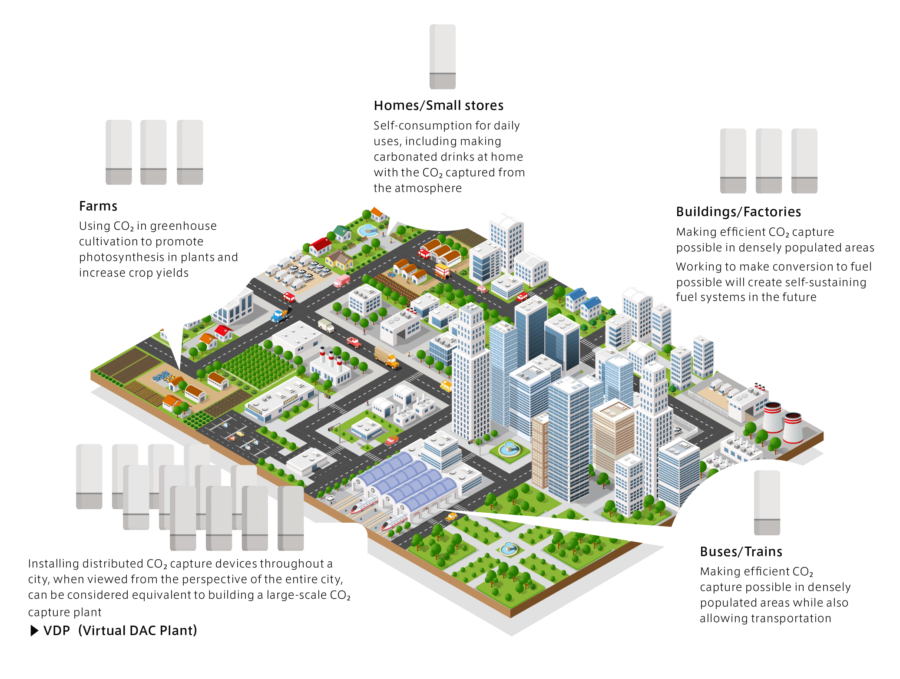
28. Stathmos
- Founding Year: 2023
- Location: Le Mans, France
- Use for: On-site Carbon Capture Solution
Stathmos manufactures Statbox, an on-site carbon capture solution. It uses advanced sorbent materials to extract CO2 and moisture from the atmosphere using renewable electricity and low-grade heat. Each unit captures around 1,000 tonnes of CO2 annually and generates clean water, benefiting regions with limited water resources.
Stathmos stores the captured CO2 in geological formations, reducing atmospheric carbon and supporting global decarbonization goals. Thus, the startup integrates carbon capture with water production to empower industries and communities toward carbon neutrality.
29. Limenet
- Founding Year: 2023
- Location: Milan, Italy
- Use for: Permanent CO2 Storage in Seawater
Limenet develops a proprietary technology that stores CO2 permanently in seawater using calcium carbonate and renewable energy for efficient processing. The system combines atmospheric or captured CO2 with seawater, producing stable calcium bicarbonate naturally present in marine environments.
The startup uses renewable energy to power equipment, enabling the reaction and ensuring efficiency and scalability in its operations. Limenet also designs its system to integrate into existing marine infrastructure, simplifying deployment and reducing implementation costs.
30. Oxylus Energy
- Founding Year: 2023
- Location: New Haven, Connecticut, US
- Use for: Electrolysis-based Carbon-neutral Fuels
- Funding: Raised USD 4.5 million seed round in September 2024
Oxylus Energy works on a proprietary electrolyzer technology that converts captured CO2 into carbon-neutral fuels and chemical feedstocks using renewable electricity. The system uses electrolysis to transform CO2 into e-methanol through a membrane and catalyst process with high efficiency.
It offers e-methanol as a sustainable alternative to fossil fuels, supporting various industries with cleaner energy solutions. The startup integrates modular carbon conversion factories with industrial emitters to enable efficient CO2 utilization on a large scale.
Discover All Emerging CleanTech Startups
The carbon capture, utilization & storage startups showcased in this report are only a small sample of all CleanTech startups we identified through our data-driven startup scouting approach. Download our free CleanTech Innovation Report for a broad overview of the industry or get in touch for quick & exhaustive research on the latest technologies & emerging solutions that will impact your company in 2025!

